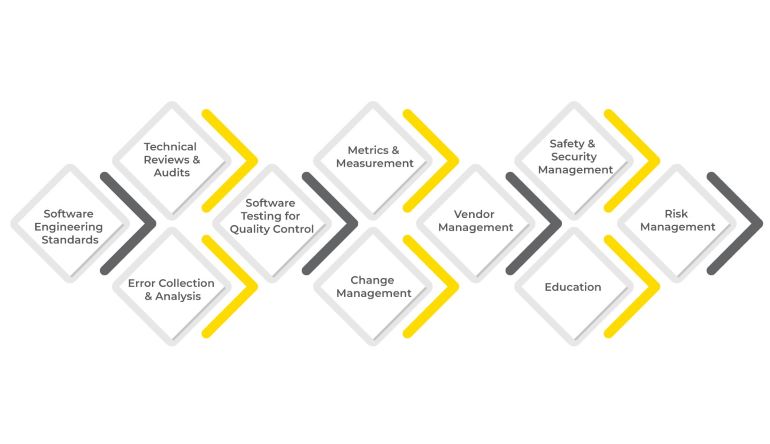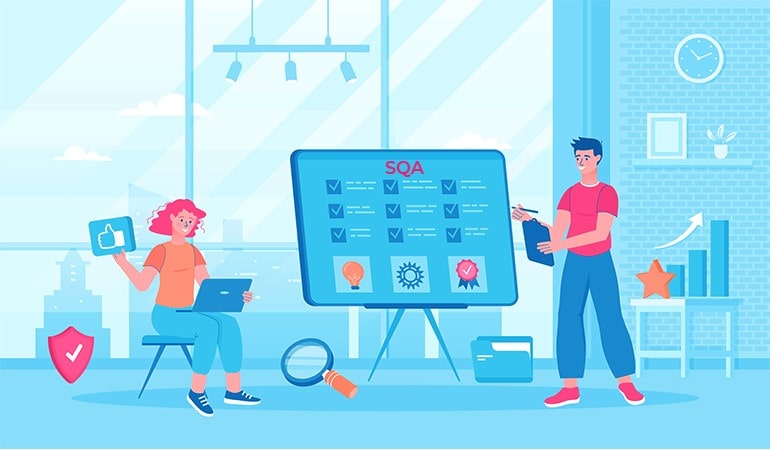Although releasing regular software updates to meet changing market dynamics is a critical success component for software houses, ensuring that software is high quality is an equally important aspect of being a successful IT company. Customers today are not only looking for a wide range of software options to choose from, but they are also keen to choose IT products that meet their criteria for good quality. Bugs and other issues often spell the death knell for a software application that fails to satisfy its users. This makes software quality assurance (SQA) an indispensable part of any IT company’s software development processes.
This article provides a beginner’s guide to software QA services, the primary components of quality assurance software and techniques, the difference between SQA and software testing, and the benefits of SQA.
What is Software Quality Assurance?
Quality is essential to any good product, be it software or automobile. Software quality assurance, or SQA, is a continuous or ongoing process that IT companies use to ensure that their product is in line with their own established quality standards, in addition to adhering to industry-wide standards and specifications. It checks if the product quality meets the set standards or not. Not to forget that it is an integral part or component of the Software Development Lifecycle where there is constant monitoring. It works parallel to the development stages.
As a process, SQA is responsible for making sure that all the software development process stakeholders do their jobs properly, such that the final product meets established standards.
This naturally means that your development team implements and executes all the development processes correctly and adequately. As such, SQA processes run simultaneously with the development processes. Rather than running quality checks once the software development is complete, your SQA team runs these checks during the various development phases.
Quality assurance software also helps ensure that any issues or bugs are identified and resolved early on in the mobile app development services, thus saving you from disappointed customers and higher development costs. Moreover, ensuring that you deliver a good quality product also helps bolster your brand reputation, increase customer loyalty, and drive business growth.
Essential Components of Software Quality Assurance
Software quality assurance (SQA) encompasses various elements and techniques to ensure the delivery of high-quality software products. SQA teams play a crucial role in upholding software engineering standards and implementing effective practices throughout the software development life cycle (SDLC).

When it comes to big data application testing and other app quality assurance, here are the key elements, activities, and techniques SQA teams use to deliver high-quality software.
Software Engineering Standards: SQA teams are responsible for enforcing software engineering standards (ISO & IEEE) to ensure consistency, reliability, and efficiency within software development teams.
Technical Reviews and Audits: The software quality assurance team’s job involves active and passive verification and validation techniques at each stage of the SDLC. This includes conducting comprehensive technical reviews and audits to assess compliance with established processes and standards.
Software Testing for Quality Control: SQA emphasizes thorough software testing services to identify and eliminate bugs or defects that may impact the quality and functionality of the software.
Error Collection and Analysis: The SQA team is also responsible for defect reporting, management, and analysis to identify patterns, problem areas, and failure trends. This helps in addressing issues promptly and improving the overall quality of the software.
Metrics and Measurement: Software quality assurance tools and techniques utilize various metrics and measurement techniques to collect data about the quality and effectiveness of both the software product and the underlying development processes. This data-driven approach aids in making informed decisions and continuously improving the software.
Change Management: Change management is also a vital component of SQA. Quality assurance in software development actively promotes controlled change management processes to mitigate the risks associated with unanticipated negative outcomes. Such risks often result from changes in the software or its environment.
Vendor Management: Software quality assurance teams must collaborate with contractors and tool vendors to ensure mutual success by aligning objectives, maintaining quality standards, and facilitating effective communication.
Safety & Security Management: SQA often takes on the responsibility of identifying vulnerabilities and proactively addressing them, ensuring the safety and security of the software.
Risk Management: Risk management also falls under the domain of software quality assurance. SQA teams spearhead risk identification, analysis, and mitigation efforts, enabling informed decision-making and reducing potential risks throughout the software development life cycle.
Education: Continuous education is vital for SQA professionals to stay up to date with the latest tools, standards, and industry trends. This ongoing learning helps them enhance their skills and adapt to evolving effective software testing practices.
Vital SQA Techniques

In addition to the above elements, SQA employs various techniques to ensure software quality. These techniques include:
Auditing – Auditing involves inspecting work products and related information to determine compliance with standard processes. It verifies adherence to established guidelines and identifies areas for improvement.
Reviewing – SQA conducts comprehensive reviews where internal and external stakeholders examine the software product, providing feedback and approval. This collaborative process enhances the quality and effectiveness of the software.
Code Inspection – This is a formal review that trained mediators or peers conduct using checklists, entry/exit criteria, and other rules. They perform static testing to detect bugs and prevent defects from entering subsequent stages. However, you should ensure that the reviewers are not the authors of the code.
Design Inspection – Software Quality Assurance tools perform design inspections using checklists to assess various aspects of software design, including general requirements, interfaces, logic, error handling, and performance. This ensures well-structured and robust designs.
Simulation – When direct testing of a real system is not feasible, SQA employs simulation tools to virtually model and analyze the behavior of the system under study. Simulators serve as valuable alternatives for testing and validating system functionality.
Performance Testing – This is a black-box technique used by SQA to validate the system’s functionality without considering the internal workings. Performance testing focuses on verifying the system’s compliance with specifications and expected features.
Standardization – SQA emphasizes standardization as a crucial aspect of quality assurance. Establishing and following standardized practices reduces ambiguity, guesswork, and inconsistencies, thereby ensuring higher quality.
Static Analysis – Software quality assurance leverages automated tools for static analysis, which involves analyzing software code or artifacts without executing the program. Static analysis tools, such as SonarCube and VeraCode, are commonly used to assess software metrics and perform reverse engineering, enabling early detection of potential issues and ensuring code quality.
Walkthroughs – These are peer reviews where the software developer guides the development team through the software product. During this process, participants raise queries, suggest alternatives, and provide comments on, software quality, potential errors, standard violations, or other issues, promoting collaboration and identifying areas for improvement.
Unit Testing – A white-box testing technique, unit testing enables comprehensive code coverage by executing each independent path, branch, and condition at least once. It validates the correctness and functionality of individual code units.
Stress Testing – SQA conducts stress testing to assess the robustness and performance of the system under heavy loads that go beyond normal conditions. This type of testing helps identify potential bottlenecks, vulnerabilities, and weaknesses, allowing for improvements and optimizations to ensure system stability.
Advantages of Implementing Software Quality Assurance
The benefits of software quality assurance are numerous. IT companies developing software use SQA for the many benefits it offers. Here are some significant benefits you can expect from developing and implementing robust SQA processes.
Enhanced Customer Satisfaction: SQA tools and techniques ensure that the software meets or exceeds customer expectations by diligently identifying and resolving issues early on. It is due to the software quality assurance techniques that issue identification is possible, which leads to a smoother user experience, increased reliability, and ultimately, happier customers.
Improved Software Reliability: Through rigorous testing, error analysis, and risk management, SQA significantly reduces the likelihood of software failures, crashes, or unexpected behavior. Users can trust the software to function as intended, fostering trust and confidence in the product.
Cost Savings: Investing in SQA upfront helps minimize the cost of fixing defects in later stages of development or after the software is deployed. By catching issues early, SQA prevents expensive rework, customer support expenses, and potential reputation damage.
Time Efficiency: SQA techniques, such as automated testing and static analysis, optimize the development process by identifying problems quickly. This allows for prompt resolution, minimizing delays, and ensuring timely software delivery to meet project deadlines.
Enhanced Security: SQA teams play a crucial role in identifying and addressing security vulnerabilities in software. By proactively detecting and mitigating potential risks, SQA helps protect sensitive data, safeguard against cyber threats, and maintain the integrity of the software and its users.
Continuous Improvement: Another key benefit of SQA is that it promotes a culture of continuous improvement within software development teams. By collecting metrics, analyzing data, and conducting thorough reviews, SQA identifies areas for enhancement and facilitates the implementation of best practices, leading to ongoing quality optimization.
Efficient Change Management: With change being inevitable in software development, SQA provides a structured approach to manage changes effectively. By implementing controlled change processes and assessing potential risks, software quality assurance processes ensure that modifications do not introduce unintended negative consequences.
Higher Efficiency and Productivity: SQA techniques, such as standardized practices and streamlined processes, contribute to improved efficiency and productivity. By reducing ambiguity, minimizing rework, and promoting consistent practices, SQA empowers teams to focus on delivering high-quality software.
Regulatory Compliance: For software products that need to adhere to specific industry regulations or standards, SQA is essential. It helps ensure compliance with legal and regulatory requirements, preventing costly penalties and legal issues.
Competitive Advantage: SQA sets software products apart from the competition by ensuring superior quality, reliability, and performance. Organizations gain a competitive edge in the market by consistently delivering software that meets or exceeds customer expectations.
Wrap Up
Overall, software quality assurance has emerged as an indispensable discipline that brings numerous benefits to both software development teams and end-users. By prioritizing quality, QA testing services help create software products that are reliable, secure, efficient, and customer-centric, fostering long-term success and satisfaction.
If you want to develop secure, high-quality enterprise software, contact us at [email protected].
FAQs
Software Quality Assurance (SQA) ensures software meets specified requirements and is of high quality.
The four types of quality assurance are process, product, organizational, and project assurance.
Software quality is measured through metrics like defect density and adherence to requirements.
Software testing is the evaluation process to identify gaps, errors, or missing requirements in a system.












